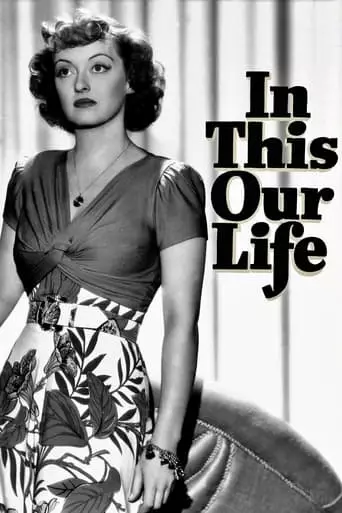An unhappy, self-centered woman runs off with her sister’s husband, wreaking havoc and ruining the lives of those around her.
In This Our Life (1942), directed by John Huston, is a compelling drama that delves into the complexities of family dynamics, betrayal, and societal issues in the American South. The narrative centers on two sisters, Stanley Timberlake (Bette Davis) and Roy Timberlake (Olivia de Havilland), whose lives become entangled in a web of deceit and moral conflict.
Stanley, the younger sister, is portrayed as a self-centered and impulsive woman who disrupts the lives of those around her. She abandons her fiancé, Craig Fleming (George Brent), to elope with her sister Roy’s husband, Peter Kingsmill (Dennis Morgan). Their marriage leads to Peter’s decline and eventual suicide, highlighting Stanley’s destructive influence. Upon returning home, Stanley attempts to rekindle her relationship with Craig, further complicating the family dynamics.
The film also addresses racial injustice through the character of Parry Clay (Ernest Anderson), a young Black man wrongfully accused of a crime by Stanley. This subplot underscores the pervasive racism of the era and adds depth to the narrative.
Main Themes
- Family Betrayal and Dysfunction
The film explores the destructive impact of betrayal within a family. Stanley’s actions cause irreparable harm to her sister Roy and others, highlighting the fragility of familial bonds.
- Racial Injustice
Through Parry Clay’s storyline, the film confronts the harsh realities of racial discrimination and the unjust treatment of Black individuals in the legal system.
- Moral Ambiguity
The characters are portrayed with complex motivations, blurring the lines between good and evil. This complexity invites viewers to question the nature of morality and human behavior.
- Gender Roles and Expectations
The film examines the societal expectations placed on women, particularly in the context of marriage and family, and how these pressures influence their actions and identities.
- Consequences of Selfishness
Stanley’s selfishness leads to tragic outcomes, serving as a cautionary tale about the repercussions of self-centered behavior on others.
Impact of the Movie
Upon its release, In This Our Life received mixed reviews. Critics praised the strong performances, particularly Bette Davis’s portrayal of Stanley, but some felt the film did not fully capture the depth of Ellen Glasgow’s Pulitzer Prize-winning novel. Despite this, the film was a commercial success, grossing up to $1. 9 million by 1973.
7 Reasons to Watch In This Our Life (1942)
- Bette Davis’s Powerful Performance
Bette Davis delivers a compelling portrayal of Stanley, a complex and morally ambiguous character. Her nuanced performance captures the character’s selfishness and vulnerability, making Stanley both detestable and pitiable.
- Exploration of Racial Injustice
The film addresses racial issues head-on, providing a candid look at the systemic racism of the era. Parry Clay’s storyline offers a poignant commentary on the struggles faced by Black individuals in America.
- Complex Character Dynamics
The intricate relationships between the characters, especially the sisters Stanley and Roy, are portrayed with depth and realism. Their interactions reflect the complexities of family bonds and personal betrayal.
- Direction by John Huston
John Huston’s direction brings a gritty realism to the film, effectively capturing the emotional intensity of the narrative. His ability to handle complex themes and characters adds depth to the story.
- Cinematic Quality
The film’s cinematography and production design effectively convey the atmosphere of the American South during the 1940s. The visual elements enhance the storytelling and immerse viewers in the setting.
- Timeless Themes
The exploration of themes such as betrayal, racial injustice, and moral ambiguity remains relevant today. The film encourages viewers to reflect on these societal issues and their contemporary implications.
- Strong Supporting Cast
The film features a talented supporting cast, including Olivia de Havilland, George Brent, and Ernest Anderson, who deliver strong performances that complement the main narrative. Their contributions add depth and richness to the film.
How Will You Feel After Watching In This Our Life (1942) ?
After watching In This Our Life, you may experience a range of emotions, from discomfort to empathy. The film’s unflinching portrayal of human flaws and societal issues prompts introspection and a deeper understanding of the complexities of human nature. The tragic outcomes of the characters’ actions may leave you reflecting on the consequences of selfishness and the importance of empathy and justice. Overall, the film offers a thought-provoking experience that lingers long after the credits roll.

